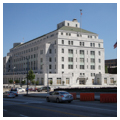You are here
Martin Luther King, Jr., Federal Building
Built during the worst years of the Depression, the Federal Post Office Annex is Atlanta’s finest modern building of the period. As in numerous contemporary government buildings and commercial facades (Atlanta’s Rhodes Center, for instance), especially those sponsored by the Public Works Administration, the Post Office Annex combines restrained Art Deco detailing with the stripped forms of minimal classicism. The set-back forms of the Post Office Annex help to monumentalize the edifice, allow for dramatic shadows and providing a weighty solidity to articulate the building mass.
Located across the street from where the Terminal Station (now razed) once stood, the Post Office Annex was originally connected to that building by tunnels for the receipt and distribution of regional mail. The economies of the day are reflected in the stark building surfaces and minimal ornament but the building nonetheless features notable entry doors, carved eagles, and an Art Deco linear pattern.
The sculptural character of this seemingly megalithic architecture appears as if carved from a massive block of stone, rather than a series of joined parts. Its classicism is neither the elaborate Corinthian nor the refined Ionic, but the masculine archaic Doric; the edifice fills its chest with deep breaths and flexes its muscular torso toward the rail yard and city at large. The building was a declaration of the substantiality and stability of government at a time when the economy was depressed nationally, and when construction in Atlanta substantially decreased. The building was intended to bring hope and confidence to a depressed city. Influenced by the modern classicism of Paul Cret, this is public architecture ennobled by a restrained simplicity and monumentality. A. Ten Eyck Brown’s other work of this period includes the Thornton Building (Ten Park Place Building) of 1932, one of the last commercial structures built before the Depression and World War II shut down commercial building activity in Atlanta.
In 2008 the building was restored, adapted to expanded governmental uses, and renamed the Martin Luther King Jr. Federal Building.
References
Craig, Robert M. Atlanta Architecture: Art Deco to Modern Classic, 1929–1959. Gretna, LA: Pelican Publishing Co., 1995.
Writing Credits
If SAH Archipedia has been useful to you, please consider supporting it.
SAH Archipedia tells the story of the United States through its buildings, landscapes, and cities. This freely available resource empowers the public with authoritative knowledge that deepens their understanding and appreciation of the built environment. But the Society of Architectural Historians, which created SAH Archipedia with University of Virginia Press, needs your support to maintain the high-caliber research, writing, photography, cartography, editing, design, and programming that make SAH Archipedia a trusted online resource available to all who value the history of place, heritage tourism, and learning.























